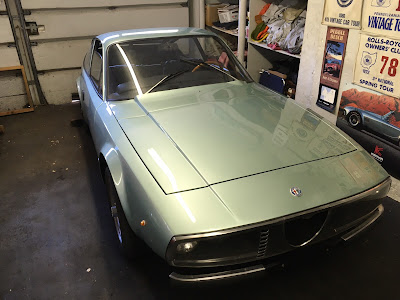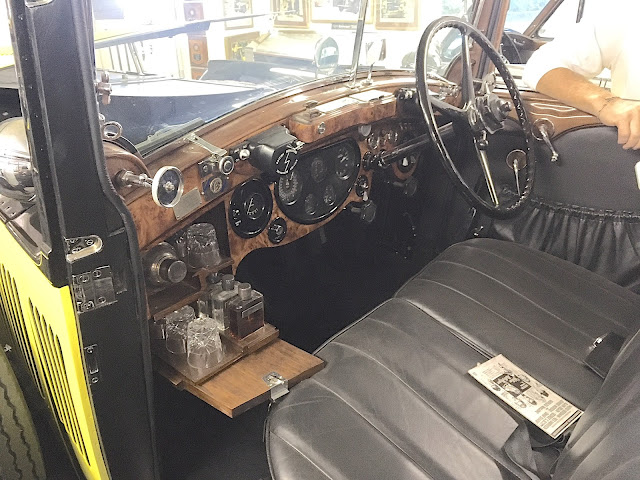At roughly mid-span of the 9-day Monterey Car Week (Aug. 12-21) I met my old friend George at an outdoor jazz concert. He introduced me to a guy who had invited him to look at his collection of what he described as "some old cars." Two days later, on a Friday morning, we went to have a look...
It developed that "some old cars" turned out to be a collection of seven classics reflecting wide and deep knowledge of the automobile, and also the owner's efforts in restoring mechanicals as well as coachwork. This red car is a Zagato-bodied Alfa Romeo SZ from the 1961-62 period, one of around 170 with alloy panels tightly contoured to Ercole Spada's design over a tubular chassis powered by Alfa's aluminum 1300cc twin-cam Veloce engine.
The big shield-shaped Alfa grille gets more emphasis on this "round tail" design than on the Kamm-tailed Coda Tronca that followed it, and on the TZ-1 following that.
The driver's work station is focused and purposeful, with side bolsters on the lightweight bucket seats to brace driver and passenger against cornering forces. Everything on the short wheelbase chassis is aligned with the goal of keeping weight down. The owner commented that the car feels alive when driven hard...

Though less focused on road racing than the Alfa SZ, Ferrari's 250GT Lusso, designed by Pininfarina and built by Scaglietti from 1962-64, reflected the tubular chassis design of the road racing GTO, and also featured 4-wheel disc brakes. Like that GTO and the Alfa SZ, the Lusso manages responsive handling with a simple live rear axle. A road racing relative, the 330 LMB, combined the Lusso's Kamm-tailed body with the GTO's nose, along with a 4 liter V12 engine. Lusso bodywork is a masterpiece of understatement, relying on careful contours and proportions, and details like the fading of the front fender tops into the door skins, instead of applied trim or visual gimmicks. Wheelbase is a compact 94 inches.
The owner suggested trying out the seat. The doors are wider and deeper than on, for example, a Jaguar E-Type, so getting in doesn't involve as many contortions...
The big speedometer and tachometer are aimed at the driver, and a row of smaller instruments includes ammeter, oil pressure and temperature, water temperature and fuel gauge. Instead of the trademark gated shift lever, the stick for the 4-speed gearbox sits in a simple leather boot. There's no radio, and no armrests or glove compartment, and the designers have placed a series of control knobs facing downwards along the base of the dash, perhaps for safety reasons. This makes reading labels, if there are any, impossible. The Lusso's designers seem to have decided that if you can't be bothered to read the owner's manual, you shouldn't drive the car. The interior design, like the exterior, pretty much excludes everything that isn't the car...
The 250 designation reflects the individual cylinder capacity; it's the classic Colombo-designed single overhead-cam V12, making about 240 bhp. Minimum dry weight was about 2,250 lb., while maximum weight was 2,890 lb. depending upon equipment, and a full load of fuel.
The 1934 Bentley 3.5 liter was, unlike the Ferrari (and the sports Bentleys built by W.O. Bentley before the 1931 takeover by Rolls Royce) aimed at cosseting its driver and passengers in smoothness and near-silence. The new Bentley was introduced in fall of 1933, just in time for the Depression, with an inline six based on the Rolls 20/25. Braking was a servo-assisted mechanical system, with a drum at each wheel. This award-winning example features 3-position drophead coupe bodywork by Thrupp and Maberly, with the radiator shell painted to match the alloy body.
Interior details include plenty of polished wood along with leather seating, and a cabinet for refreshments of a kind not encouraged by the constabulary...
As with the bar cabinet, the controls at the wheel offered lots of options, including controls for adjusting fuel mixture as well as advancing or retarding the spark.
The Bentley version of the Rolls engine made 110 hp with the aid of a crossflow cylinder head. Unlike the Bentley Mark V which came just before World War II, the 3.5 liter featured suspension by solid axles at the front as well as the rear. The cast alloy firewall is an impressive piece of work...
A different era and a simpler design brief led to the Alfa Romeo Junior Z. It was another car sketched by Ercole Spada for Zagato, and appeared at the Turin Show in 1969.
The Junior Z was bodied in steel and mounted on the same short wheelbase as the Duetto spider. Aimed at drivers wanting a lightweight, responsive car, it was initially offered in 1,300cc form, and 1510 were built with that engine. Then, in 1973, a 1,600cc version of the Giulia engine was offered, along with a slightly elongated deck.
The plexiglass nose with Alfa shield cut-out is a distinctive feature, as is the shift lever for the 5-speed transmission, which juts into your hand right below the dash. This, like the overall body design, seems to have inspired later Honda models. Alfa and Zagato managed to build another 402 Junior Zs with the 1.6 liter Giulia engine before halting production after 1975.
This 1932 Rolls Royce Phantom II Sedanca de Ville makes a pretty good contrast with the little Alfas. It's enormous, weighing well over 3 tons despite its alloy bodywork by Barker on a 150 inch wheelbase, and it was the star of the 1964 film "The Yellow Rolls Royce", along with Shirley MacLaine, Rex Harrison, Alain Delon, Ingrid Bergman and Jeanne Moreau.
Sandwiched between a 1959 Rolls Silver Cloud Series 1 and the Bentley 3.5, the Yellow Rolls Royce was rewarding but difficult to photograph. On the way to photographing the other cars, we sampled the seats on the Silver Cloud, and can report that they are exceedingly cushy...
As with the Bentley, there was plenty of polished wood, with the traditional leather seating for the chauffeur, who often sat out in the weather...
There was broadcloth-upholstered seating for the rear passengers, who enjoyed the cabinets for liquid refreshments similar to those at the front, along with the crank-operated divider window and fold-down jump seats for guests.
Pull-down shades afforded privacy on all four sides of the rear compartment...
The 7.7 liter inline 6 of the Phantom II made 122 hp, and plenty of torque. Discontinued after 1936, it was superseded by the V12 Phantom III, which somehow avoided the trouble-free reputation of the Phantom II.
Meanwhile, up at the prow, the traditional Rolls mascot, the Spirit of Ecstasy looks, well, ecstatic...
Modern car designers often torture innocent lighting fixtures into improbable shapes to fit into computer-designed fright masks. Vintage Rolls and Bentley headlights remind us that there's a more direct, if maybe less efficient, way to provide light...
The 4 1/4 liter Bentley was built at the Rolls Royce Derby works as a more torquesome companion to the 3.5 liter. This example was paneled in alloy by Wendover in the late Thirties, and reflects the same careful workmanship and conservative chassis design as the 3.5 liter car.
The Wendover-bodied Bentley, unlike the Thrupp & Maberly 3.5 liter, features a polished, chrome-plated radiator shell.
This Bentley, like the other cars on our morning tour, stands as a reminder that careful design is, in a way, its own reward, and that somewhere in California, it's always Car Week...
*Footnote:
We want to thank our host, who wishes to remain anonymous, for the time he spent in showing and discussing these cars.
Photo Credits:
All photos were taken by George Havelka except the following, which were taken by the author: Top, 2nd from top, 6th, 10th, 15th & 16th, 18th, 21st & 24th.





























No comments:
Post a Comment